小学英语全英教案范文
小学英语的全英文教案范文
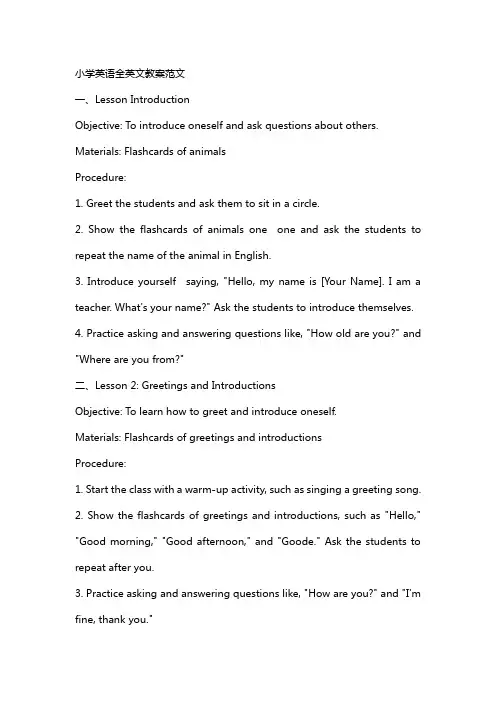
小学英语全英文教案范文一、Lesson IntroductionObjective: To introduce oneself and ask questions about others. Materials: Flashcards of animalsProcedure:1. Greet the students and ask them to sit in a circle.2. Show the flashcards of animals one one and ask the students to repeat the name of the animal in English.3. Introduce yourself saying, "Hello, my name is [Your Name]. I am a teacher. What's your name?" Ask the students to introduce themselves.4. Practice asking and answering questions like, "How old are you?" and "Where are you from?"二、Lesson 2: Greetings and IntroductionsObjective: To learn how to greet and introduce oneself.Materials: Flashcards of greetings and introductionsProcedure:1. Start the class with a warm-up activity, such as singing a greeting song.2. Show the flashcards of greetings and introductions, such as "Hello," "Good morning," "Good afternoon," and "Goode." Ask the students to repeat after you.3. Practice asking and answering questions like, "How are you?" and "I'm fine, thank you."4. Introduce a new student to the class and ask the students to greet and introduce themselves.三、Lesson 3: ColorsObjective: To learn how to name and describe colors in English. Materials: Flashcards of colorsProcedure:1. Start the class showing a colorful picture or object and ask the students to name the colors.2. Show the flashcards of colors one one and ask the students to repeat the color name in English.3. Practice describing colors using phrases like, "It's blue," "It's a red car," and "The sky is blue."4. Draw a colorful picture with the students and ask them to name the colors as you draw.四、Lesson 4: Numbers 1-10Objective: To learn how to count from 1 to 10 in English.Materials: Number flashcards, objects to countProcedure:1. Start the class counting with the students, "One, two, three, four, five." Continue counting up to 10.2. Show the number flashcards one one and ask the students to repeat the number in English.3. Give the students a set of objects, such as counters or toys, and ask them to count the objects using English numbers.4. Play a number game, such as "Simon Says" or "Number Memory," to reinforce the counting skills.五、Lesson 5: AlphabetObjective: To learn the English alphabet and the sounds of each letter. Materials: Alphabet flashcards, letter sounds chartProcedure:1. Start the class singing the "Alphabet Song" to familiarize the students with the English alphabet.2. Show the alphabet flashcards one one and ask the students to repeat the letter name in English.3. Expln the sounds of each letter in the alphabet using a letter sounds chart.4. Practice tracing the letters of the alphabet on a large whiteboard or chart paper, and ask the students to follow along.六、Lesson 6: Family MembersObjective: To learn how to name family members in English. Materials: Flashcards of family membersProcedure:1. Start the class asking the students about their family members in their native language.2. Introduce the concept of family members in English showing the flashcards of family members, such as "mother," "father," "brother," "sister," and "grandparent."3. Practice asking and answering questions about family members, like "Who is your mother?" and "I have a sister."4. Ask the students to bring a picture of their family and describe their family members in English.七、Lesson 7: Dly RoutinesObjective: To learn how to describe dly routines in English. Materials: Flashcards of dly routinesProcedure:1. Start the class discussing the dly routines of the students in their native language.2. Introduce the concept of dly routines in English showing the flashcards of dly routines, such as "wake up," "eat breakfast," "go to school," and "play."3. Practice asking and answering questions about dly routines, like "What do you do in the morning?" and "What do you do after school?"4. Ask the students to role-play their dly routines using English words and phrases.八、Lesson 8: ClothingObjective: To learn how to name and describe different types of clothingin English.Materials: Flashcards of clothingProcedure:1. Start the class discussing the types of clothing worn in different seasons.2. Introduce the concept of clothing in English showing the flashcards of different types of clothing, such as "shirt," "pants," "dress," "sunglasses," and "hat."3. Practice asking and answering questions about clothing, like "What are you wearing today?" and "I am wearing a skirt."4. Ask the students to bring a picture of themselves in different types of clothing and describe their clothing in English.九、Lesson 9: Food and DrinksObjective: To learn how to name and describe different foods and drinks in English.Materials: Flashcards of food and drinksProcedure:1. Start the class discussing the types of food and drinks liked the students.2. Introduce the concept of food and drinks in English showing the flashcards of different food and drink items, such as "apple," "banana," "orange," "milk," and "water."3. Practice asking and answering questions about food and drinks, like "What is your favorite fruit?" and "Can I have some water, please?"4. Ask the students to bring a picture of their favorite food or drink and describe it in English.十、Lesson 10: Review and AssessmentObjective: To review the topics covered in the previous lessons and assess the students' understanding.Materials: Review worksheets, flashcardsProcedure:1. Start the class reviewing the topics covered in the previous lessons, such as greetings, introductions, colors, numbers, family members, dly routines, clothing, food and drinks.2. Conduct a mini-assessment to evaluate the students' understanding asking them to answer questions related to the topics.3. Use flashcards to test the students' vocabulary retention asking them to name the items in English.4. Provide review worksheets for the students to plete, which include exercises like fill in the blanks, match the words with their pictures, and write short sentences using the learned vocabulary.5. Give feedback to the students on their performance and encourage them to continue practicing their English skills.重点和难点解析一、Lesson Introduction重点关注环节:Students' ability to ask and answer questions about themselves.难点解析:This lesson introduces the concept of asking and answering questions about oneself, which is a fundamental skill in language learning. The students may find it challenging to express their personal information accurately and confidently in English.二、Lesson 2: Greetings and Introductions重点关注环节:Students' ability to use greetings and introduce themselves.难点解析:Using proper greetings and introductions is crucial in dly munication. The students might struggle with remembering and applying the correct phrases in different situations.三、Lesson 3: Colors重点关注环节:Students' ability to name and describe colors in English. 难点解析:Naming and describing colors can be challenging for students, especially those whose native language does not use the same color palette as English.四、Lesson 4: Numbers 1-10重点关注环节:Students' ability to count from 1 to 10 in English.难点解析:Counting is a foundational math skill that can be difficult for students to master when learning a new language, as it involvesunderstanding the numerical system and sequencing.五、Lesson 5: Alphabet重点关注环节:Students' ability to recognize and pronounce each letter of the English alphabet.难点解析:The English alphabet may have letters that are not present in the students' native language, making it challenging for them to recognize and pronounce them correctly.六、Lesson 6: Family Members重点关注环节:Students' ability to name family members in English and ask about others'.难点解析:Understanding and using family vocabulary can be emotional and personal for students. They may find it difficult to remember the English words for extended family members or to ask about others' families.七、Lesson 7: Dly Routines重点关注环节:Students' ability to describe their dly routines in English. 难点解析:Describing routines involves sequencing and using past tense verbs, which can be plex for beginners to grasp.八、Lesson 8: Clothing重点关注环节:Students' ability to name and describe different types of clothing in English.难点解析:Clothing terms can be abstract and may not have directtranslations in students' native languages. Additionally, students may be self-conscious about discussing their attire.九、Lesson 9: Food and Drinks重点关注环节:Students' ability to name and describe different foods and drinks in English.难点解析:Food and drink vocabulary can be extensive, and students may have difficulty remembering the names of specific items or describing preferences.十、Lesson 10: Review and Assessment重点关注环节:Students' ability to review and apply the knowledge gned from the previous lessons.难点解析:Assessment can be stressful for students, especially if they feel unprepared. Ensuring that the review is prehensive and allows for individualized learning is crucial.这些教案环节涵盖了从自我介绍到日常生活中的各种主题,每个环节都有其特定的重点和难点。
全英版小学英语教案【三篇】
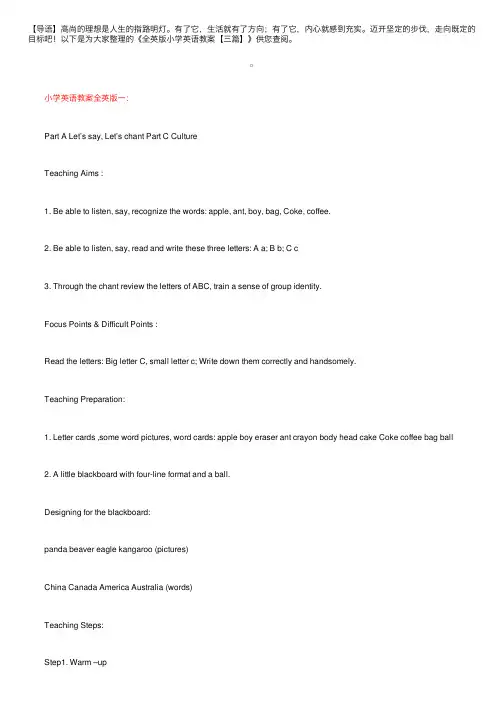
【导语】⾼尚的理想是⼈⽣的指路明灯。
有了它,⽣活就有了⽅向;有了它,内⼼就感到充实。
迈开坚定的步伐,⾛向既定的⽬标吧!以下是为⼤家整理的《全英版⼩学英语教案【三篇】》供您查阅。
⼩学英语教案全英版⼀: Part A Let’s say, Let’s chant Part C Culture Teaching Aims : 1. Be able to listen, say, recognize the words: apple, ant, boy, bag, Coke, coffee. 2. Be able to listen, say, read and write these three letters: A a; B b; C c 3. Through the chant review the letters of ABC, train a sense of group identity. Focus Points & Difficult Points : Read the letters: Big letter C, small letter c; Write down them correctly and handsomely. Teaching Preparation: 1. Letter cards ,some word pictures, word cards: apple boy eraser ant crayon body head cake Coke coffee bag ball 2. A little blackboard with four-line format and a ball. Designing for the blackboard: panda beaver eagle kangaroo (pictures) China Canada America Australia (words) Teaching Steps: Step1. Warm –up 1. Sing a song. 2. Free talk T: Hello. I’m Wendy. I’m from Hangzhou. S1: Hello! I’m ... I’m from Hangzhou,too. T: Nice to meet you. S: Nice to meet you, too. T: Let’s play. Ok? S: Great! T: Watch out! (T throws the ball.) S: Oh, no. Make a similar dialogue with your partner. Step2.Presentation. 1. 1)T : Today, we will learn letters. Do you know letters? Just as A,B,C…… They are letters. What’s the meaning of letters? S: 字母。
小学英语全英万能教案模板
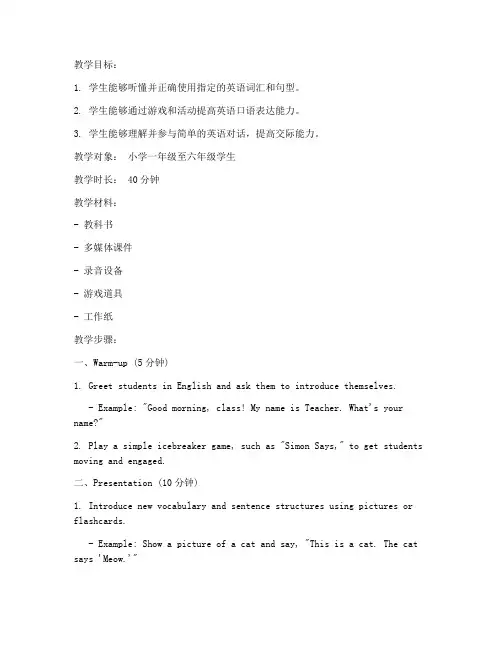
教学目标:1. 学生能够听懂并正确使用指定的英语词汇和句型。
2. 学生能够通过游戏和活动提高英语口语表达能力。
3. 学生能够理解并参与简单的英语对话,提高交际能力。
教学对象:小学一年级至六年级学生教学时长: 40分钟教学材料:- 教科书- 多媒体课件- 录音设备- 游戏道具- 工作纸教学步骤:一、Warm-up (5分钟)1. Greet students in English and ask them to introduce themselves.- Example: "Good morning, class! My name is Teacher. What's your name?"2. Play a simple icebreaker game, such as "Simon Says," to get students moving and engaged.二、Presentation (10分钟)1. Introduce new vocabulary and sentence structures using pictures or flashcards.- Example: Show a picture of a cat and say, "This is a cat. The cat says 'Meow.'"2. Use a PowerPoint or whiteboard to demonstrate the vocabulary and sentence structures.- Example: "Can you show me a book? Yes, I can show you a book. Can you give me a pen? Yes, I can give you a pen."三、Practice (15分钟)1. Pair students up and have them practice the new vocabulary and sentence structures in a dialogue format.- Example: "A: What's this? B: This is a ball. A: Can you throw the ball? B: Yes, I can throw the ball."2. Organize a role-play activity where students act out a short scenario using the new language.- Example: "A: I want to go to the park. B: OK, let's go to the park together."四、Game (10分钟)1. Play a fun and interactive game related to the new vocabulary and sentence structures.- Example: "Memory Game" where students find matching pictures or cards with the new vocabulary.五、Conclusion (5分钟)1. Review the new vocabulary and sentence structures with the class.- Example: "Today we learned about animals. Can you tell me what an animal says?"2. Have students create a short sentence using the new vocabulary.- Example: "I see a dog. The dog says 'Woof.'"六、Homework (5分钟)1. Assign a simple homework task to reinforce the lesson.- Example: "Draw a picture of your favorite animal and write a sentence about it."七、Assessment- Observe student participation and engagement during the activities.- Check homework submissions for understanding and application of the new language.备注:- 根据学生的年龄和英语水平,调整教学材料和活动难度。
英文教案小学全英模板
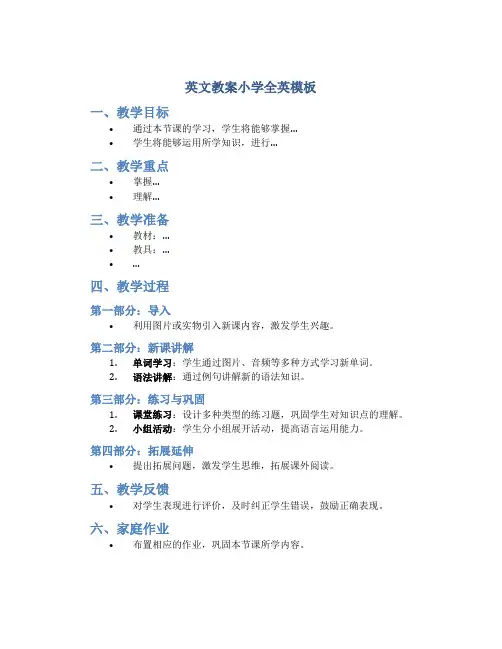
英文教案小学全英模板
一、教学目标
•通过本节课的学习,学生将能够掌握…
•学生将能够运用所学知识,进行…
二、教学重点
•掌握…
•理解…
三、教学准备
•教材:…
•教具:…
•…
四、教学过程
第一部分:导入
•利用图片或实物引入新课内容,激发学生兴趣。
第二部分:新课讲解
1.单词学习:学生通过图片、音频等多种方式学习新单词。
2.语法讲解:通过例句讲解新的语法知识。
第三部分:练习与巩固
1.课堂练习:设计多种类型的练习题,巩固学生对知识点的理解。
2.小组活动:学生分小组展开活动,提高语言运用能力。
第四部分:拓展延伸
•提出拓展问题,激发学生思维,拓展课外阅读。
五、教学反馈
•对学生表现进行评价,及时纠正学生错误,鼓励正确表现。
六、家庭作业
•布置相应的作业,巩固本节课所学内容。
七、教后反思
•总结本节课教学过程,查找不足并设想改进方法。
这个教案模板旨在帮助老师规划和设计一堂全英文的小学英语课程,灵活运用各种教学方法,提高学生的学习兴趣和语言运用能力。
希望能为您的英语教学提供一定的参考价值。
小学英语优秀教案全英
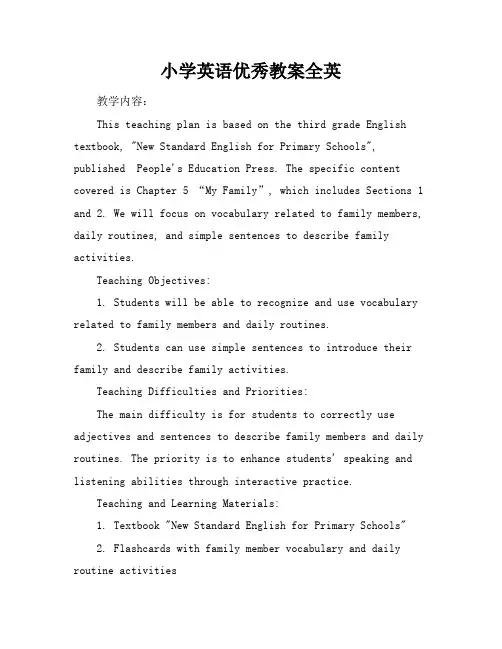
小学英语优秀教案全英教学内容:This teaching plan is based on the third grade English textbook, "New Standard English for Primary Schools", published People's Education Press. The specific content covered is Chapter 5 “My Family”, which includes Sections 1 and 2. We will focus on vocabulary related to family members, daily routines, and simple sentences to describe family activities.Teaching Objectives:1. Students will be able to recognize and use vocabulary related to family members and daily routines.2. Students can use simple sentences to introduce their family and describe family activities.Teaching Difficulties and Priorities:The main difficulty is for students to correctly use adjectives and sentences to describe family members and daily routines. The priority is to enhance students' speaking and listening abilities through interactive practice.Teaching and Learning Materials:1. Textbook "New Standard English for Primary Schools"2. Flashcards with family member vocabulary and daily routine activities3. A board or screen for displaying visual aids4. Handouts with exercises for practiceTeaching Process:1. Warmup (5 minutes)A song about family will be played to create an engaging atmosphere.Students will do a quick mime activity to practice actions related to daily routines.2. Presentation (15 minutes)Introduce new vocabulary using flashcards and pictures.Present and practice target sentences with the whole class.3. Practice (15 minutes)Group work: Students create short dialogues using the new vocabulary.Pair work: Students practice asking and answering questions about family and daily routines.4. Guided Production (10 minutes)Students work in pairs to create a poster about their family.Each pair presents their poster to the class, using full sentences to describe their family members and activities.5. Production (10 minutes)Students engage in a roleplaying activity where they interview each other about their family life.Selected students will share their interviews with the class.6. Review and Consolidation (5 minutes)A quick review game to reinforce the new vocabulary and sentence structures.Oral feedback will be provided to correct and improve students' language use.Blackboard Design:The blackboard will be divided into two sections:One side will list the new vocabulary.The other side will have the main sentence structures of the lesson.Homework Design:1. Write a short paragraph introducing their family and describing what they do together.Sample Answer: My family has four members. We like to watch TV together every evening.2. Draw a family tree and label each family member using the new vocabulary.(No sample answer provided, as this is a creative activity.)Postclass Reflection and Extension:After the lesson, I will reflect on the effectiveness of the teaching methods and whether students have met the objectives. I will adjust future lessons based on students' performance and feedback. For extension, students can write a short story about a day spent with their family, includingthe activities they enjoy together.Note: This plan incorporates practical situations, example explanations, inclass exercises, and ensures that the teaching language is precise and the content flows coherently.重点和难点解析:1. 教学难点与重点的明确;2. 教学过程中的互动活动设计;3. 板书设计;4. 作业设计;5. 课后反思及拓展延伸。
小学pep英语教案5篇
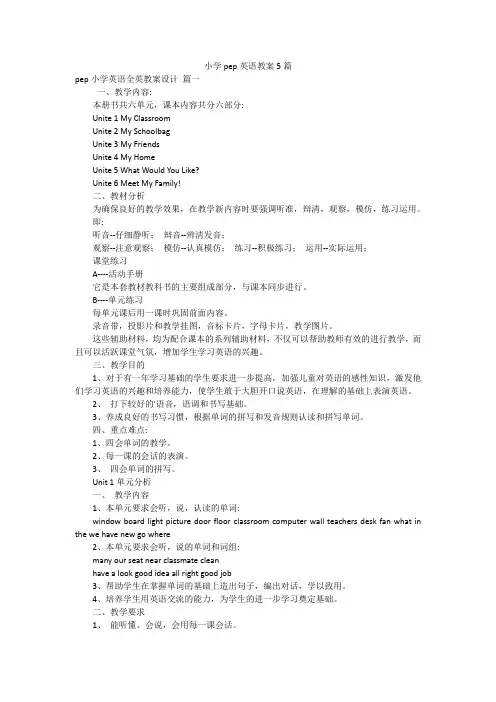
小学pep英语教案5篇pep小学英语全英教案设计篇一一、教学内容:本册书共六单元,课本内容共分六部分:Unite 1 My ClassroomUnite 2 My SchoolbagUnite 3 My FriendsUnite 4 My HomeUnite 5 What Would You Like?Unite 6 Meet My Family!二、教材分析为确保良好的教学效果,在教学新内容时要强调听准,辩清,观察,模仿,练习运用。
即:听音--仔细静听;辩音--辨清发音;观察--注意观察;模仿--认真模仿;练习--积极练习;运用--实际运用;课堂练习A----活动手册它是本套教材教科书的主要组成部分,与课本同步进行。
B----单元练习每单元课后用一课时巩固前面内容。
录音带,投影片和教学挂图,音标卡片,字母卡片,教学图片。
这些辅助材料,均为配合课本的系列辅助材料,不仅可以帮助教师有效的进行教学,而且可以活跃课堂气氛,增加学生学习英语的兴趣。
三、教学目的1、对于有一年学习基础的学生要求进一步提高,加强儿童对英语的感性知识,激发他们学习英语的兴趣和培养能力,使学生敢于大胆开口说英语,在理解的基础上表演英语。
2、打下较好的'语音,语调和书写基础。
3、养成良好的书写习惯,根据单词的拼写和发音规则认读和拼写单词。
四、重点难点:1、四会单词的教学。
2、每一课的会话的表演。
3、四会单词的拼写。
Unit 1单元分析一、教学内容1、本单元要求会听,说,认读的单词:window board light picture door floor classroom computer wall teachers desk fan what in the we have new go where2、本单元要求会听,说的单词和词组:many our seat near classmate cleanhave a look good idea all right good job3、帮助学生在掌握单词的基础上造出句子,编出对话,学以致用。
小学英语全英教案万能模板
Grade Level: 2nd GradeSubject: EnglishDuration: 45 minutesObjective:1. Students will be able to describe their favorite animal using simple sentences.2. Students will practice speaking and listening skills through various activities.3. Students will expand their vocabulary related to animals.Materials:1. Whiteboard and markers2. Flashcards with pictures of different animals3. Colored pencils4. Handouts with animal-related questions5. Audio tape or MP3 player for listening exercisesTeaching Procedure:1. Warm-up (5 minutes)- Start the class with a simple song or a rhyme related to animals to get students' attention and make them comfortable with the topic.- Ask students to stand up and do some simple stretching exercises.2. Introduction (5 minutes)- Show a picture of an animal on the whiteboard and ask students what it is.- Use the question "What's your favorite animal?" to introduce the topic of the lesson.- Explain that today's class will be about describing their favorite animal.3. Vocabulary Building (10 minutes)- Hand out flashcards with pictures of different animals to each student.- Ask students to name the animals and write down any new vocabulary they learn.- Use the phrase "I like..." to introduce the animals and their names.4. Listening Exercise (5 minutes)- Play a short audio clip with animal sounds or a story about animals.- Ask students to listen carefully and answer questions related to the listening material.- Questions can include: What animal is making the sound? What is happening in the story?5. Speaking Activity (10 minutes)- Divide the class into small groups of 3-4 students.- Each group will choose one animal from the flashcards and discuss their favorite animal in English.- Encourage students to use new vocabulary and simple sentences to describe their animal.- Rotate groups and provide feedback on their speaking skills.6. Writing Activity (10 minutes)- Give each student a handout with animal-related questions, such as:- What is your favorite animal?- Why do you like it?- What does it look like?- What does it do?- Ask students to write a short paragraph about their favorite animal using the questions as a guide.- Encourage students to draw a picture of their animal to accompany their writing.7. Review and Conclusion (5 minutes)- Have a class discussion about the favorite animals that students mentioned.- Ask students to share their writing and pictures with the class.- Review the new vocabulary and correct any mistakes made during the speaking and writing activities.Homework:1. Students should bring a picture of their favorite animal to class next time.2. Practice using the new vocabulary and sentences at home.Assessment:- Observe students' participation and engagement during the activities.- Assess the quality of students' writing and speaking skills based on their responses and performance in class.- Evaluate the understanding of new vocabulary through quizzes or games.。
小学英语范文英文版小学英语教案范文
小学英语范文英文版小学英语教案范文第一章:问候与自我介绍1.1 教学目标学生能够用英语进行简单的问候和自我介绍。
学生能够理解和使用基本的英语礼貌用语。
1.2 教学内容常用的英语问候语如“Hello”,“Good morning”,“Good afternoon”,“Good evening”,“How are you?”等。
自我介绍的表达方式,如“My name is”,“I am from”,“I am in grade”等。
1.3 教学活动教师与学生进行示范对话,展示如何用英语问候和自我介绍。
学生分组进行角色扮演,练习用英语进行问候和自我介绍。
教师组织学生进行小组活动,互相练习问候和自我介绍。
1.4 作业与评估学生回家后,与家人用英语进行问候和自我介绍。
教师观察学生在课堂上的表现,评估他们对于问候和自我介绍的掌握程度。
第二章:数字与计数2.1 教学目标学生能够用英语正确地数数和表达数字。
学生能够理解和使用基本的英语计算用语。
2.2 教学内容数字0到10的读写和表达方式。
基本的加减法运算的表达方式,如“+”,“-”,“=”等。
2.3 教学活动教师教授数字0到10的读写和表达方式,并进行示范。
学生进行数数练习,从0数到10。
学生进行简单的加减法运算练习,如1+1,2-1等。
2.4 作业与评估学生回家后,练习数数和简单的加减法运算。
教师观察学生在课堂上的表现,评估他们对于数字和计数的掌握程度。
第三章:颜色3.1 教学目标学生能够用英语正确地表达各种颜色。
学生能够理解和使用基本的英语颜色词汇。
3.2 教学内容常用的英语颜色词汇,如“red”,“blue”,“green”,“yellow”,“black”,“white”等。
3.3 教学活动教师教授颜色词汇,并进行示范。
学生在教师的指导下,进行颜色认知和表达的练习。
学生分组进行颜色配对游戏,提高颜色词汇的应用能力。
3.4 作业与评估学生回家后,练习表达颜色词汇。
小学英语全英教案【通用6篇】
小学英语全英教案【通用6篇】(经典版)编制人:__________________审核人:__________________审批人:__________________编制单位:__________________编制时间:____年____月____日序言下载提示:该文档是本店铺精心编制而成的,希望大家下载后,能够帮助大家解决实际问题。
文档下载后可定制修改,请根据实际需要进行调整和使用,谢谢!并且,本店铺为大家提供各种类型的经典范文,如总结报告、演讲发言、规章制度、员工手册、创业计划、企划方案、心得体会、法律文书、教学资料、其他范文等等,想了解不同范文格式和写法,敬请关注!Download tips: This document is carefully compiled by this editor. I hope that after you download it, it can help you solve practical problems. The document can be customized and modified after downloading, please adjust and use it according to actual needs, thank you!Moreover, our store provides various types of classic sample texts, such as summary reports, speeches, rules and regulations, employee manuals, entrepreneurial plans, planning plans, insights, legal documents, teaching materials, other sample texts, etc. If you want to learn about different sample formats and writing methods, please pay attention!小学英语全英教案【通用6篇】小学英语全英教案篇一Section CCould you give us some advice on how to learn English well? 公安县自强初级中学杜亚兰Ⅰ.Material analysis 本课是九年级第三单元第三话题的第三课时。
小学英语全英教案(17篇)
小学英语全英教案(17篇)篇1:全英教案篇5:小学英语全英说课稿篇9:小学英语全英说课稿篇10:小学英语全英说课稿I’ll finish this lesson in five steps。
step1 lead--in activitiesI will begin my class with “drawing and guessing” game,just like this : I show students some vehicles such as bike ,bus ,jeep which they learned before by “Stick Figures” and ask them guess what’s it。
Purpose: It is important to form a better English learning surrounding for the Ss by guessing game。
and at the same time it provides situations to review learned knowledge for the next step。
step2 prestentationNow I’ll mainly talk about this step。
1、first there is a Free talk between T and Ss。
For example: I show many pictures of beautiful cities and ask students some questions,such as “do you like this city?where do you want to go ?”and help Ss to answer them with “by train ,by plane,by ship”。
- 1、下载文档前请自行甄别文档内容的完整性,平台不提供额外的编辑、内容补充、找答案等附加服务。
- 2、"仅部分预览"的文档,不可在线预览部分如存在完整性等问题,可反馈申请退款(可完整预览的文档不适用该条件!)。
- 3、如文档侵犯您的权益,请联系客服反馈,我们会尽快为您处理(人工客服工作时间:9:00-18:30)。
小学英语全英教案范文【篇一:全英文英语教案模板】lesson plannsefc module2 unit reading in teacher:period:period1 type:readingduration: 45minutesteaching ideologythe current theory view reading as a interactive process which involves not only the printed page but also the reader’s old knowledge of the language in general, the world and the text types. in the reading process, these factors interact with each other and compensate for each other. based on the understanding of reading as an interactive process, teaching reading in the classroom is divided into three stages in which the top-down and bottom-up techniques integrated to develop the students language efficiency in general and reading strategies. the three stages are pre-reading, while-reading and post-reading.teaching material and learning conditionthe analysis of teaching materialthe teaching material is the reading part from nsefc module2 unit. the topic of this unit is . this passage mainly introduces the passage consists of paragraphs. the first paragraph is a general introduction of the . para.2 to para.4 introduces . the last paragraph tells about . the topic is not new to the ss. but there is some new words and phases in the passage.the analysis of learning conditionthe students are from grade1 in senior high school. as high school students, they have achieved certain english level and they have the ability to get the basic idea of the reading. since they are in grade1, they are easily activated and want to air their own opinions on the topic. they are familiar with the topic of and know some. but they may not know before. moreover, their vocabulary is limited so they may have difficulties in understanding some sentences.learning objectives1. language skillsat the beginning of the class, ss can predict the content of the passage based on the title. ? ss can scan the passage and find out the specific information such as the person related withss can summarize the passage with the help of the clues of the passage.2. language knowledgess can master the key words and phrases of the passage as follows, . ? ss can learn , especially3. affectsss will realize that and they will concern themselves with the issue of4. cultural awarenessss will broaden their minds by knowing something about5. learning strategiesss will cultivate their ability individual learning and cooperative learning by doing someactivities independently and some in groups.ss will communicate with each other in english while doing the group work.language difficultiesfocuses and anticipatedlanguage focusesthis is a reading period so the focus is to cultivate the students’ reading skills. the many activities are designed to help ss to train their reading skills, such as predicting, skimming, scanning and summarizing.it is also important for the ss to master the new words and phrases.anticipated difficultiesas the ss have a limited vocabulary, so they may have some difficulties in understanding the passage. so the teacher will help them learn the new words and phrases.ss may did not heard before, so the teacher will tell them some background knowledge about it.teaching methodthree-stage model: based on the understanding of reading as an interactive process, teaching reading in the classroom is divided into three stages in which the top-down and bottom-up techniques integrated to develop the students languageefficiency in general and reading strategies. the three stages are pre-reading, while-reading and post-reading.teaching aidsmultimedia devices and ppt documents: in order to help ss to fully understand the whole passage, i adopt multimedia devices and ppt documents to bring the real-life situation into the classroom.teaching proceduresstep1. lead-in (6min)activity1. greetings and free-talking (2min)t leads into the topic by asking ss some they know. ss tell the name of the they know freely.t: hello boys and girls. (ss say hello to the teacher.)t: when we say , what appears in your minds? (ss tell the things appear in their minds freely.) t: what are the ? (ss tell some names of .)activity2. picture-talking (4min)t shows some pictures about the in china and abroad. after seeing the pictures, ss are expected to tell the similarities of them.t: just now, you talk about some in china. now, let’s see some pictures of some . (t shows the pictures and ss see them carefully.)t: what do the have in common?for example, they are very precious. what are your opinions?(t gives them some hints and ss tell the characteristics of )[aims]in this step, t first leads in the topic by talking with the ss freely about the whichis familiar to them and then ss see some pictures and tell the characteristics. these two activities aim to arouse the ss’ interests in the topic and activate their old knowledge of . then ss will be mentally prepared for the reading comprehension. what’s more,when they are talking about the charateristics of, they will realize that theare rare and precious and they will concern themselves with the issue of .step2. pre-reading (3min)activity1. knowing something about (1min)t gives a brief introduction of the. ss will know the t: today, we are going to learn . it is . do you know what is? (t shows some pictures ofand ss get to know the .)activity2. predicting (2min)t asks ss to read the title of the passage and then ask them some questions. ss will predict the content of the passage with the help of the title.t: please look at the title “”, what does “” mean?(if the ss can not give the answer, then t explain it.)t: in search means that people are looking for it. why are people looking for it? can you guess? what will the passage talk about?(ss predict the content, but t will not give the answer here.)[aims]in this step, the ss first know some information of the ; the background information will make it easier for the ss to understand the passage. then t asks ss to make predictions about the passage. it aims to help ss develop the reading skills of predicting.step3. while-reading (22min)activity1. skimming (4min)ss skim the whole passage and find out and check their predictions. t: why are people still ? here is a multiple choice for you.activity2. scanning (3min)t presents several true or false statements and asks the ss to scan the passage and judge the right from the wrong.(keys: F,F,T,T,F)activity3 close-reading (15min)t designs various kinds of activities and ss do the activities to fully understand the passage. para.1t: please read para.1 carefully and then take some note about the .para.2-4please read para.2-4 carefully and then find out the removal of the room.please read para.2-4 carefully and then find out the person related with the amber room and the things them down with it. para.5please read para.5 carefully and then find out the the rebuilding of the amber room.【篇二:pep小学英语全英教案模板】the english teaching planof pep book 4enhe primary school teacher:___________the curriculum scheduleclass:____________class:____________the teaching schedulethe students’ result tablethe english curriculum standard英语课程标准一级目标总体目标:对英语有好奇心,喜欢听他人说英语;能根据教师的简单指令做游戏、做动作、做事情(如涂颜色、连线);能做简单的角色扮演;能唱简单的英文歌曲,说简单的英语歌谣;能在图片的帮助下听懂和读懂简单的小故事;能交流简单的个人信息,表达简单的情感和感觉;能书写字母和单词;对英语学习中接触的外国文化习俗感兴趣。
